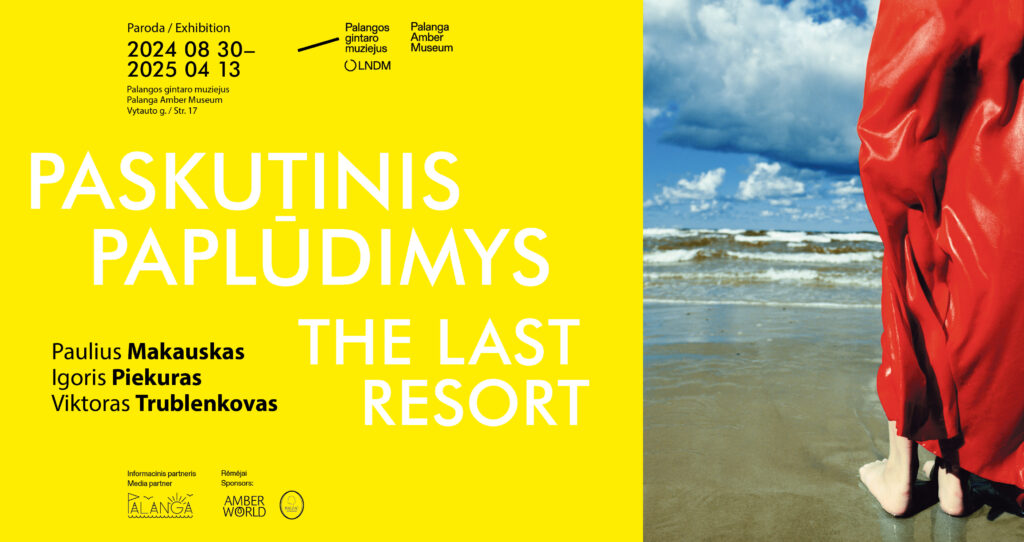The Last Beach
30 August 2024 – 13 April 2025
 The Baltic Sea is sometimes described as the most polluted sea in the world. Meanwhile, its beaches are (still) promoted as supposed vast havens of wild nature – the largest and sandiest ones in Europe. This can be seen as a strange contradiction that encourages us to consider the beach phenomenon from various points of view. Spending summers by the Baltic became increasingly popular in the early 20th century. Several generations of holidaymakers contributed to the widespread custom of spending leisure time at the seaside. At the same time, the expanding tourism industry and the adverse effects of climate change around the world have contributed to the destruction of delicate natural areas around the world. While resorts are attracting visitors, unfortunately, what amounts to a sandy and nowadays rather homogenised global middle-class dream, i.e., the shores of places like San Diego, Miami and other exotic lands, is, for all kinds of reasons, shrinking. In Lithuania, we are not yet feeling the effects of any looming cataclysms. Yet, we do sometimes long for an ‘unspoilt’ corner of nature, an ‘untouched’ stretch of coastline, a safe haven where we could relax and pleasantly lose ourselves.
The Baltic Sea is sometimes described as the most polluted sea in the world. Meanwhile, its beaches are (still) promoted as supposed vast havens of wild nature – the largest and sandiest ones in Europe. This can be seen as a strange contradiction that encourages us to consider the beach phenomenon from various points of view. Spending summers by the Baltic became increasingly popular in the early 20th century. Several generations of holidaymakers contributed to the widespread custom of spending leisure time at the seaside. At the same time, the expanding tourism industry and the adverse effects of climate change around the world have contributed to the destruction of delicate natural areas around the world. While resorts are attracting visitors, unfortunately, what amounts to a sandy and nowadays rather homogenised global middle-class dream, i.e., the shores of places like San Diego, Miami and other exotic lands, is, for all kinds of reasons, shrinking. In Lithuania, we are not yet feeling the effects of any looming cataclysms. Yet, we do sometimes long for an ‘unspoilt’ corner of nature, an ‘untouched’ stretch of coastline, a safe haven where we could relax and pleasantly lose ourselves.
Let us come even closer to the water with our bare feet. These gentle ripples, these boundless shimmering horizons bring us algae, unusual bacteria, and seaweed. And, along with them, particles that are invisible to the naked eye but give a soft sheen to the entire visible surface. Does the point in modernity and the part of the world where the scarlet-draped figure from Viktor Trublenkov’s photograph – the strange timeless colossus of humanity towering above marine clouds – has paused, matter? Light encourages a silent dialogue with the water. It is actively present in Paulius Makauskas’s photographic series New Seas. Perhaps the interplay of bright colours reflects micro-organisms of some kind. Or maybe even dangerous chemical compounds spilled nearby. Are these really the seas of our planet? The air we breathe in the backwaters of the Earth is also sometimes permeated by invisible toxic particles and colourful dust. Flames burst out of Igoris Piekuras’s mid-1970s smouldering landfill, reminding us of the environmental issues of the previous decades; they have not gone away. Islands of rubbish, almost entire multi-coloured continents are forming not only at the edges of woodlands but also in the distant oceans, yet we only experience them indirectly, through reports in the media on humanity’s landfills in the water and zones in our seas where life is no longer sustained. Gases in the air, like microplastics in the waves, are not visible to the naked eye; we would not be able to know the composition of coastal water without laboratory tests. Global changes in various spheres are only knowable piecemeal, never all at once. This almost irritating particularism disturbs us and our hedonistic enjoyment of the seaside as anxiety creeps into our minds.
One day, the current holiday makers will have passed, and these havens on sunny shores will have become lost to oblivion. Most likely, they will be taken over by water, and it is said to happen much sooner than previously thought. Those devising plans for humanity’s escape may try to tame the oceans of outer space. But even then, some of us will have memories of the seaside from our childhood… the literal, unmetaphorical last beach somewhere over the horizon, or perhaps even nearby.
Skaidra Trilupaitytė
17 Vytauto st, LT-00101, Palanga, Lithuania
(+370 460) 30314
gintaro.muziejus@lndm.lt













